
The Philadelphia History Museum at the Atwater Kent at 15 South 7th Street between Market and Ranstead Streets in Center City, Philadelphia was founded in 1938 to be Philadelphia's city history museum. The museum occupies architect John Haviland's landmark Greek Revival structure built in 1824–26 for the Franklin Institute. The Museum operates as a city agency as part of Philadelphia's Department of Recreation.

The New Jersey Historical Society is a historical society and museum located in Newark, Essex County, New Jersey, United States. The Historical Society is housed in the former headquarters of the Essex Club. It has two floors of exhibition space, a gift shop, and a hall for lectures. The NJHS offers occasional Newark walking tours. The Society formerly published the academic journal, New Jersey History.

The John Muir National Historic Site is located in the San Francisco Bay Area, in Martinez, Contra Costa County, California. It preserves the 14-room Italianate Victorian mansion where the naturalist and writer John Muir lived, as well as a nearby 325-acre tract of native oak woodlands and grasslands historically owned by the Muir family. The main site is on the edge of town, in the shadow of State Route 4, also known as the "John Muir Parkway."
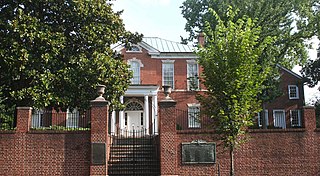
The National Society of the Colonial Dames of America is an American organization composed of women who are descended from an ancestor "who came to reside in an American Colony before 1776, and whose services were rendered during the Colonial Period." The organization has 45 corporate societies and over 15,000 members. The national headquarters are at Dumbarton House in Georgetown, Washington, D.C.

The Fillmore House, or Millard Fillmore House, is a historic house museum at 24 Shearer Avenue in East Aurora in Erie County, New York. Built in 1826, it was from then until 1830 the residence of the 13th President of the United States, Millard Fillmore. Moved twice and significantly altered, it is the only surviving building other than the White House associated with Fillmore's life. It was designated a National Historic Landmark in 1974. The house is owned by the Aurora Historical Society and has been decorated with period furnishings. As of 2015, it is open to the public from June through October on Wednesdays, Saturdays and Sundays from 1-4.
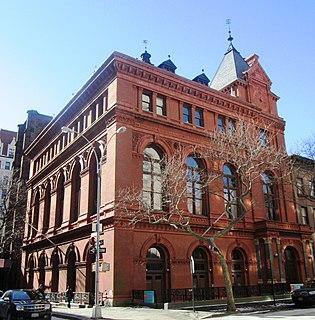
The Brooklyn Historical Society (BHS), founded in 1863, is a museum, library, and educational center preserving and encouraging the study of Brooklyn's 400-year history. The society's Romanesque Revival building, located at Pierrepont and Clinton Streets in Brooklyn Heights, was designed by George B. Post and built in 1878-81, is a National Historic Landmark and part of New York City's Brooklyn Heights Historic District. The Brooklyn Historical Society houses materials relating to the history of Brooklyn and its people, and hosts exhibitions which draw over 9,000 members a year. In addition to general programming, BHS serves over 70,000 public school students and teachers annually by providing exhibit tours, educational programs and curricula, and making its professional staff available for instruction and consultation.

The Browns Point Lighthouse is a lighthouse located near Tacoma on Browns Point at the east entrance to Puget Sound's Commencement Bay, Pierce County, Washington.

The Boca Raton Old City Hall is a historic site in Boca Raton, Florida, United States. It is located at 71 North Federal Highway. The former city hall now houses the Boca Raton Welcome Center and the Boca Raton History Museum. On October 16, 1980, it was added to the U.S. National Register of Historic Places. The original design was by Addison Mizner. On April 18, 2012, the AIA's Florida Chapter placed it on its list of Florida Architecture: 100 Years. 100 Places as Boca Raton Town Hall.

HistoryMiami Museum, formerly known as the Historical Museum of Southern Florida, is a museum located in Downtown Miami, Florida, United States. HistoryMiami Museum is the largest history museum in the State of Florida. HistoryMiami houses four permanent galleries and up to three traveling exhibits, Archives and Research Center, the South Florida Folklife Center, the Education Center, and City Tours program. Each February, HistoryMiami also hosts the annual Miami International Map Fair, the largest map fair in the Western Hemisphere.

The Alexander Ramsey House is a historic house museum in Saint Paul, Minnesota, United States; the former residence of Alexander Ramsey, who served as the first governor of Minnesota Territory and the second governor of the state of Minnesota. It was listed on the National Register of Historic Places in 1969. It is also a contributing property to the Irvine Park Historic District.

Dexter Cabin was the Leadville, Colorado home and hunting lodge of James V. Dexter, a mining investor and businessman. Although it is a cabin, the interior has been described as "surprisingly plush," "elegantly finished," and "incredibly ornate.".
Historic preservation in New York is activity undertaken to conserve forests, buildings, ships, sacred Indian burial grounds, water purity and other objects of cultural importance in New York in ways that allow them to communicate meaningfully about past practices, events, and people. Governmental programs for historic preservation range from Federal ownership and active operation of sites to grants and subsidies provided by state government, municipal support of museums and interpretative displays. Nonprofit programs include activities of statewide and local historical associations and museums, and activities of historical societies and museums at the national level. Quasi-governmental organizations, such as the New York State Thruway Authority and Thousand Islands Bridge Authority, play a role as well. Private endeavors, such as investment and other choices made by private landowners to conserve historical features of their properties, are significant but less visible and include groups such as the Historic Districts Council, The New York Landmarks Conservancy and the Preservation League of New York State. During the reconstruction of the World Trade Center site in July 2010, a team of archaeologists discovered a 32-foot-long boat. The craft was at least 200 years old, dating from a time when the Hudson River was partly filled with trash and debris because of a rapidly expanding lower Manhattan.

The Byers–Evans House Museum is a historic house museum in Denver, Colorado, United States.
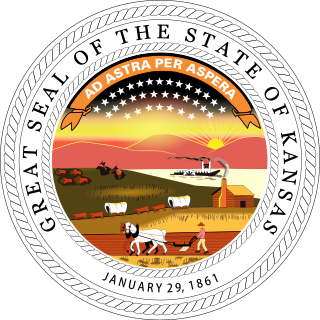
The Kansas Historical Society is the official state historical society of Kansas.
History Colorado is a twenty-first-century historical society that was established in 1879 as the State Historical Society of Colorado, also known as the Colorado Historical Society. History Colorado is a 501(c)(3) organization and an agency of the State of Colorado under the Department of Higher Education.
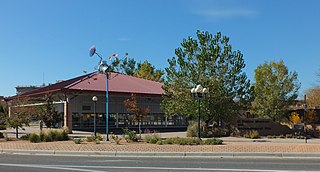
El Pueblo History Museum is a local history museum in Pueblo, Colorado, United States. The museum presents the history of Pueblo, together with the cultural and ethnic groups of the region. The historical site includes an 1840s-style adobe trading post and plaza and the archaeological excavation site of the original 1842 El Pueblo trading post which was listed on the US National Register of Historic Places in 1996. The facility is administered by History Colorado.

The William Tanner House Museum, also known as the William A. Tanner House, is a historic residence and museum in Aurora, Illinois. It was built in 1857 for William A. Tanner, a hardware merchant. His descendants lived in the house until it was donated to the Aurora Historical Society in 1936. It now operates as a Victorian-period historic house museum.
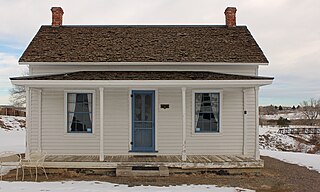
The Gully Homestead is a former homestead located at 200 S. Chambers Road in Aurora, Colorado.

The Comstock House is a historic house museum in Moorhead, Minnesota, United States. It was built for Solomon Comstock and his family from 1882 to 1883 in a mix of Queen Anne and Eastlake style. Comstock (1842–1933) was one of Moorhead's first settlers and an influential figure in business, politics, civics, and education in the growing city and state.

The Colorado Springs Pioneers Museum is located at 215 S. Tejon Street in Colorado Springs, Colorado. The granite building with a domed clock tower was the El Paso County Courthouse building from 1903 to 1973. The museum, which moved to this location in 1979, has fine arts, artifacts and archival collections that document the Pikes Peak region. The building is on the National Register of Historic Places.






















